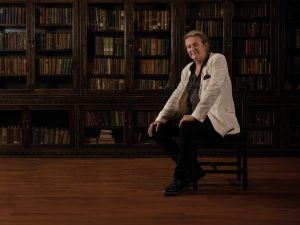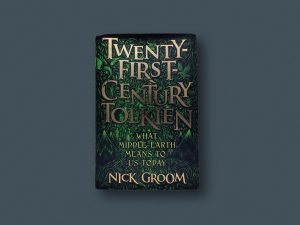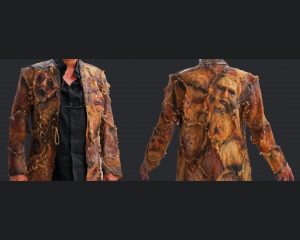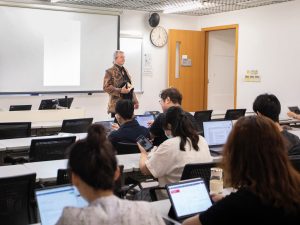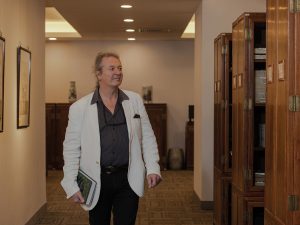If you have the chance to attend a class on Children’s Literature at the University of Macau (UM), you may be amazed by this scene: a character from a fairy tale dressed in a vintage Gothic costume is lecturing students, leading them on a journey about the culture and value of children’s stories. The name of this ‘character’ is Prof Nick Groom in the Department of English. With more than 30 years of teaching experience, Prof Groom has held positions in universities in the UK and the US. He has studied the English writer J.R.R. Tolkien and his most famous work, The Lord of the Rings, for many years. He recently published the book Twenty-First Century Tolkien: What Middle-Earth Means To Us Today, which has been praised highly by international media and is regarded as a must-read for fans of The Lord of the Rings. To Prof Groom, the emotional resonance evoked by classic literature provides hope that can help us in difficult times.
Engaging Students in the World of Literature
Back in the Children’s Literature classroom, Prof Groom takes from his leather briefcase a Mickey Mouse plush toy, which he introduces as his ‘pet’, and sits it on his shoulder. From Goldilocks and the Three Bears to Little Red Riding Hood, from Alice’s Adventures in Wonderland to Winnie-the-Pooh, Prof Groom, together with his pet, never fails to captivate students with the enchantment of fairy tales; his classroom abounds with laughter. Moreover, by leading students to appreciate children’s literature from a child’s perspective, he enables them to travel back to their own childhoods: they feel free to read nursery rhymes aloud with exaggerated and humorous body language. Their immersion in the discussion means that a 75-minutes class is over in the blink of an eye.
Prof Groom joined UM as a professor of English literature in 2020. He has previously taught at the University of Exeter, the University of Bristol, and the University of Oxford. He has also held visiting professorships at the University of Chicago and Stanford University. With his expertise in literature, Prof Groom has enriched the curriculum of UM’s Department of English. For example, he has added two courses to the department curriculum: ‘Special Topics in English: Tolkien – From the Fifth Century to the Present Day’ and ‘Nineteenth-Century Gothic Literature’. ‘With my special research perspective, I believe I can bring something new to the Department of English, as well as enable students to rethink literature so that they can learn about the value of literature through classic works,’ he says.
Building an Outlook on Life Through Literature
Born in the town of Northampton in East Midlands of England, Prof Groom was a quiet child who liked spending his time reading alone in the town library. It was through books that he learned about the outside world. In 1985, he was admitted to the University of Oxford, where he studied English Language and Literature. Three years later, he received his bachelor’s degree with double first-class honours. He continued his studies at Oxford and received his master’s and doctorate degrees. Well-read as he is, Prof Groom has a keen interest in biography. In particular, as a child he was fascinated by the biographies of those who were involved in the major conflicts in the 20th century. ‘As a literary genre, biography can be seen as an additional source of history. I read The Red Fighter Pilot: The Autobiography of the Red Baron when I was very young: The Fokker triplane he piloted was amazing,’ says Prof Groom.
Prof Groom has been writing stories since he was seven. While his schoolmates’ compositions were generally one to two pages in length, Groom could easily write ten pages. Moreover, as he read, he thought about his relationship with the particular story or book. He would also write down inspirations he derived from reading. The more he wrote, the more he realised he was writing literary criticism. The literary works read by Prof Groom span many genres, from Shakespeare’s plays to the classic stories of Charles Dickens, from which Groom hopes to understand more about life. However, he is still enamoured of the epic fantasy novel The Lord of the Rings.
According to Prof Groom, most of Tolkien’s published stories were written during World War II between 1936 and 1949. The plots of many of his works depict wars between different ethnic groups, which would easily encourage people to associate the fictional stories with the real world. ‘What should we do in the face of a seemingly hopeless endgame? How do we find a balance between success and failure? I guess we are also exploring human nature when we try to answer these questions,’ says Prof Groom.
Boldness in Creative Writing
The Lord of the Rings has stood the test of time. There have been many adaptations of this classic work, from radio shows to the movie series directed by Peter Jackson, to the TV series on Amazon Prime. As Prof Groom points out, the most admirable thing about Tolkien’s novels lies in his fertile imagination. This imagination was able to conjure the boundless Middle-earth, which is a fantastical world inhabited by different species, each with their own languages, scripts, and customs, all crafted in astonishing detail. He adds, ‘The younger generation in the 21st century nowadays also have their own imagination and understanding of Middle-earth; they are breathing new life into Tolkien’s works through reinterpretation.’
More often than not, writers use existing places and peoples to tell their stories, with an ending already planned carefully in their minds. However, Tolkien did not follow this rule. As explained by Prof Groom, Middle-earth was originally not as detailed as it appeared later. Tolkien was constantly designing the characters and planning the history of Middle-earth as he was writing—he was thinking on his feet. It also explains why the stories are full of deliberate contradictions and ambiguities. ‘This reflects the reality,’ explains Prof Groom. ‘It is never possible to look at the world holistically. There is always something that goes against your understanding or aesthetics. Therefore, as you read about Middle-earth, you can also see how Tolkien explores this legendarium together with his readers. This is very bold creative writing,’ he adds.
Having studied Tolkien and The Lord of the Rings for many years, Prof Groom’s book of literary criticism Twenty-First-Century Tolkien: What Middle-Earth Means To Us Today, published by the British publishing house Atlantic Books, was released in September 2022. Within a few days of its publication, the book was reviewed in the Swiss press Le Temps, the US press Washington Post, and the UK press Mail on Sunday—where it was described as ‘Fascinating… Wonderfully exhilarating’ and regarded as a must-read for fans of The Lord of the Rings. It has since been republished in an expanded edition and a US edition, and several translations are in preparation.
Shaping Research Interests
In addition to his extensive literary knowledge and gentlemanly demeanour, Prof Groom also brought with him from England to Macao his classic books, which can be found on the bookshelves in his office. This reveals another identity of Prof Groom: he is also a connoisseur of literary manuscripts and historical relics. He can often be seen visiting art markets, where he enjoys discovering antiques and judging their authenticity. This passion can be traced back to his research on the 18th-century English poet Thomas Percy during his doctoral studies in the early 1990s—it was a defining project that provided some direction toward his future academic research.
Prof Groom remembers a serendipitous discovery during his journey from the University of Oxford to his parents’ house. While he was walking, he unexpectedly encountered Percy’s old house, which was located a mere five miles from his parents’ house. The overwhelmed Groom felt an instant connection with the English poet—they shared the same hometown. This connection also dropped hints about his dissertation topic: Thomas Percy. As a result, Groom embarked on his extensive research about the poet. He made trips to history museums to study Percy’s correspondence, manuscripts, and writings, delving into the historical background and styles of his works. Groom also analysed how the public at that time viewed Percy’s works. He eventually compiled his research into a book titled The Making of Percy’s Reliques, which was published by Oxford University Press.
The completion of Groom’s doctoral studies also helped shape his research interests. His research areas primarily include cultural formation and authenticity, including attribution studies and literary forgery; national and regional identities (primarily UK, Irish, and Anglophone); cultural environmentalism and intangible cultural heritage; and historicist readings of the Gothic from earliest times to the present day. To date, Prof Groom has published 8 academic monographs, edited 12 books, and authored more than 100 academic papers.
Prof Groom says, ‘My research endeavours began with the study of the ancient poetry collected by Percy, which I have since extended to many other themes and academic fields. For example, by comparing texts from different time periods and regions, I can delve deeper into various social and cultural issues, thus having more profound discussions and interpretations. I also reflect on the impact on and significance for us in the present moment as I compare the texts.’
Reflecting on Life Through Literature During COVID-19
Classic literature is considered classic because it touches the depths of human emotions, creating resonance and empathy between readers and the stories’ protagonists. Prof Groom completed Twenty-First-Century Tolkien during pandemic restrictions. During this time, he contemplated the life lessons drawn from COVID-19. He shared with his students his reflections. ‘Tolkien also went through the devastating Spanish flu pandemic that started after the end of World War I. Like us, who were born a century later, Tolkien also had to learn to deal with isolation, alienation, restriction, and loss of confidence in life. These situations can be compared to that of Arwen, the immortal beauty in The Lord of the Rings. Falling in love with a mortal man, she had to give up her immortality and endure years of solitude before her eventual death.’
Drawing these connections between life and literature, Prof Groom continues: ‘Life is full of ups and downs. Tolkien himself also suffered the ravages of war and the pain of illness. With that said, overcoming these challenges is a victory in itself. The Lord of the Rings teaches us that we will never know how evil our enemy (or inner demon) is until victory is achieved. I hope that students can learn from the beautiful literary world how to regain balance and courage during challenging times and understand how to establish their own purpose and meaning in life.’
Text / Kelvin U, UM Reporter Dong Lexuan
Photo / Jack Ho, Senior UM Reporter Matt LioEnglish Translation / Bess Che
Source: UMagazine ISSUE 28

